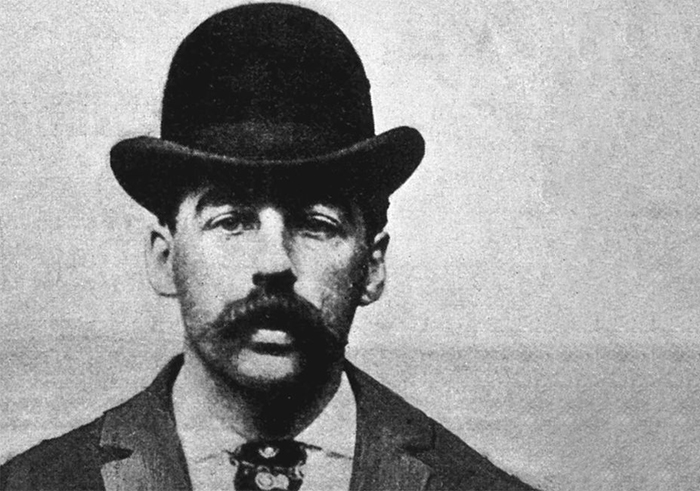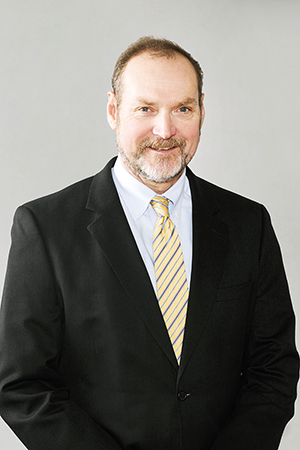"American Ripper?"

Mugshot of Herman Mudgett, alias H.H. Holmes, America's first-known serial killer.
Dickinson alumnus takes part in History Channel investigation into Holmes and Ripper murders
by MaryAlice Bitts-Jackson
Pennsylvania lawyer Douglas Maloney ’77 had never before petitioned an exhumation, let alone the exhumation of one of the world’s most infamous criminals. And yet here he was, peering into the open grave of America’s first-known serial killer, as part of a high-profile investigation examining whether the “Chicago monster” was connected to the unsolved Jack the Ripper slayings of 1888.
The findings will be revealed as part of an eight-part History Channel series, “American Ripper,” premiering July 11 at 10 p.m. (EDT). As the lawyer who petitioned the court to exhume H.H. Holmes’ body on behalf of his descendants, Maloney got a peek into the ongoing investigation into two of history's most chilling murder cases, and he is slated to appear in the series.
Peeking inside the 'murder house'
The documentary series centers on Holmes, a cunning and creative con man and pharmacist, born under the name Herman Mudgett, who built a "murder castle" hotel across the street from his pharmacy, not long after Jack the Ripper terrorized London in 1888. That chamber of horrors—complete with false doors, windowless rooms, a gas chamber, torture racks and chutes—was Holmes’ weapon of choice, and no one knows quite how many workers and Chicago World’s Fair visitors entered it and never lived to tell the tale. Estimates of his victim count range from 20 to 200.
Crime buffs still visit the Chicago site where Holmes' labyrinthine hotel once stood, and several books are bringing the Holmes case to a still wider audience. One, Devil in the White City, has recently been optioned to be made into a major motion picture, starring Leonardo DiCaprio and directed by Martin Scorsese. Another, Bloodstains, was written by Holmes' great-great grandson, Jeff Mudgett, and it puts forth a controversial theory about the case—that Holmes was in London at the time of the Ripper killing spree and either committed or orchestrated the Whitechapel murders.

Douglas Maloney '77.
“It’s an interesting theory, and the circumstantial evidence is provocative,” says Maloney, who notes that, according to Mudgett's investigation reports, Holmes’ handwriting is strikingly similar to the Ripper's, and his mugshot photo, shown above, bears a likeness to Scotland Yard's Ripper sketches. Holmes had medical training, as the Ripper is believed to have, and there is no evidence to disprove Mudgett's theory that Holmes was in London when the Ripper murders occurred.
Going where the evidence leads
The new History Channel investigation pairs Mudgett with an ex-CIA analyst and a team of forensic experts, and applies modern scientific techniques to century-old evidence. It also probes a second part of the Holmes mystery—whether Holmes is buried at the suburban-Philadelphia gravesite that bears his birth name. According to a well-documented rumor—perhaps stoked by the convicted murderer’s unusual burial requests—Holmes used his considerable wealth to escape execution.
To prove or disprove that legend, three of Holmes’ descendants requested an exhumation and DNA analysis of the remains in the Pennsylvania grave. Thanks to a colleague’s referral, Maloney became the lawyer who petitioned the court on the Mudgett family's behalf.
“It was completely out of my wheelhouse,” says Maloney, a member of a prestigious law firm in Bucks County, Pennsylvania, and former assistant district attorney, who quickly boned up on exhumation procedure and law before filing a petition with the Orphan’s Court of Delaware County.
As he observed the exhumation, Maloney was intrigued not only by the unfolding criminal investigation, but also by the methods used to recover the century-old remains. “It was fascinating to see the archaeologists at work," the former Dickinson Latin major says, adding that the scene called to his mind one of his fondest Dickinson memories—a two-week summer study-abroad archaeology dig in England with Professor Leon Fitz.
Maloney will learn the results of the Philadelphia dig and DNA testing, and the findings of the Holmes-Ripper investigation, along with the rest of us, as the eight-part History Channel series airs. He also will then discover if his interview with the documentarians is included in the series.
Asked if he has a hunch about the controversial investigation’s results, Maloney chuckles. “In doing litigation, I’ve been surprised so many times by what appear to be implausible things that tend to be true,” he says, “so I try to keep an open mind and just see where the evidence leads.”
Learn more
Published July 10, 2017